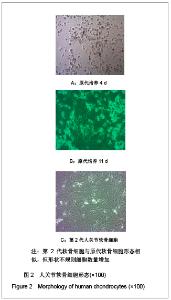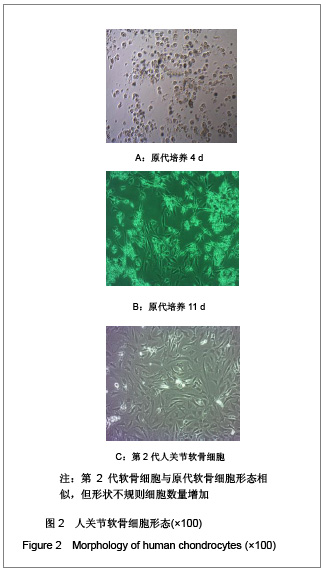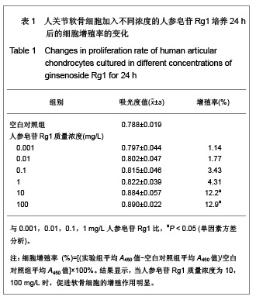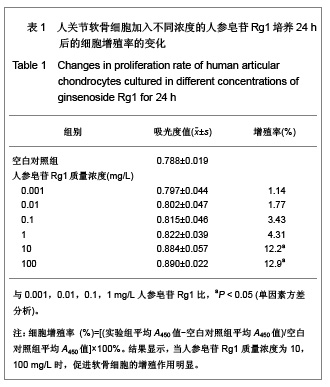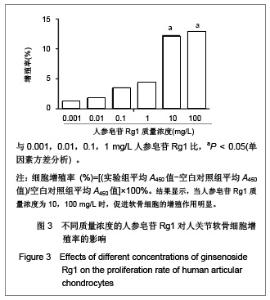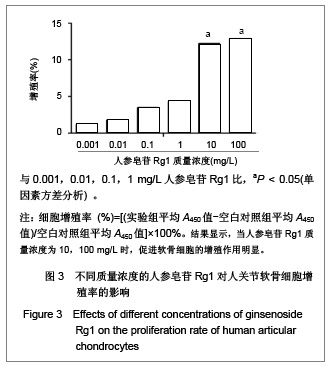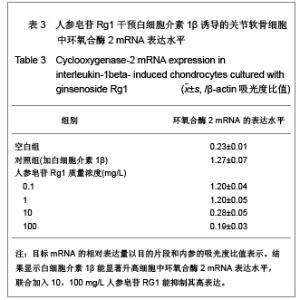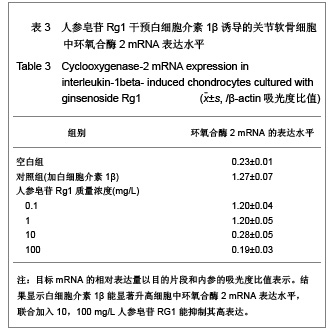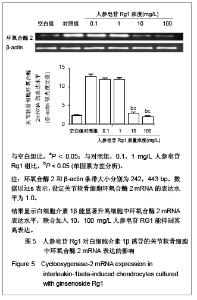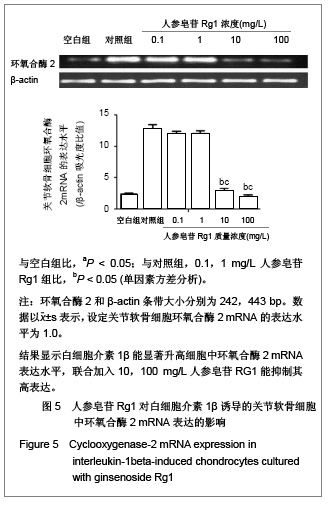Chinese Journal of Tissue Engineering Research ›› 2013, Vol. 17 ›› Issue (11): 1917-1924.doi: 10.3969/j.issn.2095-4344.2013.11.003
Previous Articles Next Articles
Effect of ginsenoside Rg1 on type Ⅱ collagen expression in chondrocytes
Zhang Ye-yong, Cheng Wen-dan, Chen Zhe-feng, Fan Wei-min, Liu Feng
- Department of Orthopedics, First Affiliated Hospital of Nanjing Medical University, Nanjing 210029, Jiangsu Province, China
-
Received:2012-12-08Revised:2012-12-29Online:2013-03-12Published:2013-03-12 -
Contact:Liu Feng, Doctor, Associate professor, Master’s supervisor, Department of Orthopedics, First Affiliated Hospital of Nanjing Medical University, Nanjing 210029, Jiangsu Province, China njliuf@hotmail.com -
About author:Zhang Ye-yong★, Master, Department of Orthopedics, First Affiliated Hospital of Nanjing Medical University, Nanjing 210029, Jiangsu Province, China 402321300@qq.com
CLC Number:
Cite this article
Zhang Ye-yong, Cheng Wen-dan, Chen Zhe-feng, Fan Wei-min, Liu Feng. Effect of ginsenoside Rg1 on type Ⅱ collagen expression in chondrocytes[J]. Chinese Journal of Tissue Engineering Research, 2013, 17(11): 1917-1924.
share this article
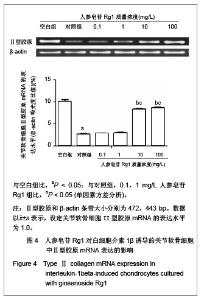
人关节软骨细胞给予不同质量浓度的人参皂苷Rg1(0.001,0.01,0.1,1,10,100 mg/L)100 μL/孔培养24 h,CCK-8染色结果显示,不同质量浓度人参皂苷Rg1对软骨细胞增殖均有一定促进作用(F=6.144,P < 0.05)。但与对照组相比,人参皂苷Rg1质量浓度为0.001,0.01,0.1,1 mg/L时促进软骨细胞的增殖作用不明显,差异无显著性意义(P > 0.05)。当人参皂苷Rg1质量浓度为10,100 mg/L时,促进软骨细胞的增殖作用明显,差异有显著性意义(P < 0.05)。 2.3 人参皂苷Rg1对白细胞介素1β诱导的人骨关节炎模型中软骨细胞Ⅱ型胶原及环氧合酶2 mRNA表达的影响 反转录PCR结果显示,24 h后,各组软骨细胞中Ⅱ型胶原mRNA表达的差异有显著性意义(F= 1 028.143,P < 0.05)。空白组软骨细胞中Ⅱ型胶原mRNA的相对表达量为1.01±0.04,而单纯加入白细胞介素1β的对照组中人软骨细胞Ⅱ型胶原mRNA的相对表达量下降至空白组的1/4,为0.27±0.01,差异有显著性意义(P < 0.05),见图4。"
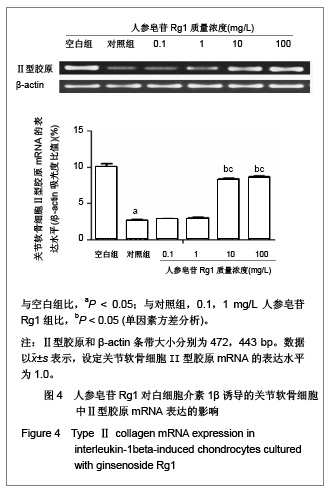
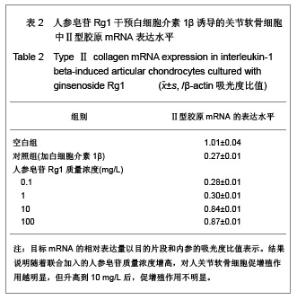
与对照组相比,而联合加入0.1和1 mg/L人参皂苷Rg1时,人软骨细胞中Ⅱ型胶原mRNA的表达没有明显变化(P > 0.05);随着联合加入人参皂苷Rg1质量浓度的升高,当人参皂苷Rg1质量浓度为10和100 mg/L时,人软骨细胞中Ⅱ型胶原mRNA的表达明显受到抑制(P < 0.05)。且10和100 mg/L人参皂苷Rg1干预的人软骨细胞中Ⅱ型胶原mRNA的表达明显高于0.1, 1 mg/L人参皂苷Rg1干预的细胞(P < 0.05),说明Rg1质量浓度越高,对人关节软骨细胞的增殖促进作用越明显。但是10和100 mg/L人参皂苷Rg1干预的人软骨细胞中Ⅱ型胶原mRNA的表达差异无显著性意义(P > 0.05),说明Rg1质量浓度的升高到一定程度后,增加Rg1质量浓度对人关节软骨细胞的增殖促进作用不明显,见图4,表2。"

| [1] Malemud CJ, Islam N, Haqqi TM. Pathophysiological mechanisms in osteoarthritis lead to novel therapeutic strategies. Cells Tissues Organs. 2003;174(1-2):34-48.[2] Blom AB, van der Kraan PM, van den Berg WB. Cytokine targeting in osteoarthritis. Curr Drug Targets. 2007;8(2): 283-292.[3] Shakibaei M, John T, Schulze-Tanzil G, et al. Suppression of NF-kappaB activation by curcumin leads to inhibition of expression of cyclo-oxygenase-2 and matrix metalloproteinase-9 in human articular chondrocytes: Implications for the treatment of osteoarthritis. Biochem Pharmacol. 2007;73(9):1434-1445. [4] Xia L, Chen Q, Cheng GL. Effects of ginseng total saponin on traumatic brain edema of rats. Zhongguo Zhong Xi Yi Jie He Za Zhi. 2012;32(12):1671-1674. [5] Ginseng helps cancer-related fatigue. Mayo Clin Health Lett. 2012;30(12):4. [6] Al-Hazmi MA, Rawi SM, Arafa NM, et al. The potent effects of ginseng root extract and memantine on cognitive dysfunction in male albino rats. Toxicol Ind Health. 2013, in press. [7] Avsar U, Karakus E, Halici Z, et al. Prevention of bone loss by panax ginseng in a rat model of inflammation-induced bone loss. Cell Mol Biol (Noisy-le-grand). 2013;59 Suppl:OL1835- 1841. [8] Mucalo I, Raheli? D, Jovanovski E, et al. Effect of American ginseng (Panax quinquefolius L.) on glycemic control in type 2 diabetes. Coll Antropol. 2012;36(4):1435-1440. [9] Kim SD, Kim YJ, Huh JS, et al. Improvement of erectile function by Korean red ginseng (Panax ginseng) in a male rat model of metabolic syndrome. Asian J Androl. 2013, in press. [10] Hong SH, Suk KT, Choi SH, et al. Anti-oxidant and natural killer cell activity of Korean red ginseng (Panax ginseng) and urushiol (Rhus vernicifera Stokes) on non-alcoholic fatty liver disease of rat. Food Chem Toxicol. 2013, in press. [11] Lee CS, Lee JH, Oh M, et al. Preventive effect of Korean red ginseng for acute respiratory illness: a randomized and double-blind clinical trial. J Korean Med Sci. 2012;27(12): 1472-1478. [12] Cheon SY, Cho KJ, Lee JE, et al. Cerebroprotective effects of red ginseng extract pretreatment against ischemia-induced oxidative stress and apoptosis. Int J Neurosci. 2013, in press. [13] Lei Y, Tao LL, Wang GL. Effect of extracts from Panax ginseng, Panax notoginseng, and ligusticum chuanxiong on vascular smooth muscle cells of aging and hypertension rats. Zhongguo Zhong Xi Yi Jie He Za Zhi. 2012;32(10):1374-1379. [14] Ramesh T, Kim SW, Hwang SY, et al. Panax ginseng reduces oxidative stress and restores antioxidant capacity in aged rats. Nutr Res. 2012;32(9):718-726. [15] Jiao L, Wan D, Zhang X, et al. Characterization and immunostimulating effects on murine peritoneal macrophages of oligosaccharide isolated from Panax ginseng C.A. Meyer. J Ethnopharmacol. 2012;144(3):490-496.[16] Shi AW, Wang XB, Lu FX, et al. Ginsenoside Rg1 promotes endothelial progenitor cell migration and proliferation. Acta Pharmacol Sin. 2009;30(3):299-306. [17] Zhou Y, Yang B, Jiang R, et al. Mechanism of ginsenoside Rg1 in the delayed senescence of hematopoietic stem cell. Zhonghua Yi Xue Za Zhi. 2010;90(48):3421-3425.[18] Wang NY, Lu CJ, Chen XH. Study on effect of ginsenoside Rg1 in promoting myocardiac vascular endothelial cell regeneration through induction on bone marrow stem cell's migration and differentiation in rabbits of myocardial infarction. Zhongguo Zhong Xi Yi Jie He Za Zhi. 2005;25(10):916-919.[19] Fang F, Chen X, Huang T, et al. Multi-faced neuroprotective effects of Ginsenoside Rg1 in an Alzheimer mouse model. Biochim Biophys Acta. 2012;1822(2):286-292.[20] Du J, Cheng B, Zhu X, et al. Ginsenoside Rg1, a novel glucocorticoid receptor agonist of plant origin, maintains glucocorticoid efficacy with reduced side effects. J Immunol. 2011;187(2):942-950.[21] Lv ZC, Guo YX, Cao XY, et al. Shijie Zhongxiyi Jiehe Zazhi. 2010(1):32-34. 吕振超,郭艳幸,曹向阳,等.人参皂苷Rgl、Rbl对体外培养膝软骨细胞凋亡的影响[J].世界中西医结合杂志,2010(1):32-34.[22] Kim HA, Kim S, Chang SH, et al. Anti-arthritic effect of ginsenoside Rb1 on collagen induced arthritis in mice. Int Immunopharmacol. 2007;7(10):1286-1291. [23] Cheng AW, Stabler TV, Bolognesi M, et al. Selenomethionine inhibits IL-1β inducible nitric oxide synthase (iNOS) and cyclooxygenase 2 (COX2) expression in primary human chondrocytes. Osteoarthritis Cartilage. 2011;19(1):118-125. [24] Chen XY, Hao YR, Wang Z, et al. The effect of vascular endothelial growth factor on aggrecan and type Ⅱ collagen expression in rat articular chondrocytes. Rheumatol Int. 2012; 32(11):3359-3364. [25] Goldring MB. Anticytokine therapy for osteoarthritis. Expert Opin Biol Ther. 2001;1(5):817-829.[26] Blom AB, van der Kraan PM, van den Berg WB. Cytokine targeting in osteoarthritis. Curr Drug Targets. 2007;8(2): 283-292.[27] Lotz M. Cytokines in cartilage injury and repair. Clin Orthop Relat Res. 2001;(391 Suppl):S108-115.[28] Alvarez-Soria MA, Largo R, Santillana J, et al. Long term NSAID treatment inhibits COX-2 synthesis in the knee synovial membrane of patients with osteoarthritis: differential proinflammatory cytokine profile between celecoxib and aceclofenac. Ann Rheum Dis. 2006;65(8):998-1005.[29] Giannoni P, Cancedda R. Articular chondrocyte culturing for cell-based cartilage repair: needs and perspectives. Cells Tissues Organs. 2006;184(1):1-15. |
| [1] | Huang Dengcheng, Wang Zhike, Cao Xuewei. Comparison of the short-term efficacy of extracorporeal shock wave therapy for middle-aged and elderly knee osteoarthritis: a meta-analysis [J]. Chinese Journal of Tissue Engineering Research, 2021, 25(9): 1471-1476. |
| [2] | Peng Zhihao, Feng Zongquan, Zou Yonggen, Niu Guoqing, Wu Feng. Relationship of lower limb force line and the progression of lateral compartment arthritis after unicompartmental knee arthroplasty with mobile bearing [J]. Chinese Journal of Tissue Engineering Research, 2021, 25(9): 1368-1374. |
| [3] | Liu Xiangxiang, Huang Yunmei, Chen Wenlie, Lin Ruhui, Lu Xiaodong, Li Zuanfang, Xu Yaye, Huang Meiya, Li Xihai. Ultrastructural changes of the white zone cells of the meniscus in a rat model of early osteoarthritis [J]. Chinese Journal of Tissue Engineering Research, 2021, 25(8): 1237-1242. |
| [4] | Liu Xin, Yan Feihua, Hong Kunhao. Delaying cartilage degeneration by regulating the expression of aquaporins in rats with knee osteoarthritis [J]. Chinese Journal of Tissue Engineering Research, 2021, 25(5): 668-673. |
| [5] | Ma Zetao, Zeng Hui, Wang Deli, Weng Jian, Feng Song. MicroRNA-138-5p regulates chondrocyte proliferation and autophagy [J]. Chinese Journal of Tissue Engineering Research, 2021, 25(5): 674-678. |
| [6] | Xie Chongxin, Zhang Lei. Comparison of knee degeneration after anterior cruciate ligament reconstruction with or without remnant preservation [J]. Chinese Journal of Tissue Engineering Research, 2021, 25(5): 735-740. |
| [7] | Cao Xuhan, Bai Zixing, Sun Chengyi, Yang Yanjun, Sun Weidong. Mechanism of “Ruxiang-Moyao” herbal pair in the treatment of knee osteoarthritis based on network pharmacology [J]. Chinese Journal of Tissue Engineering Research, 2021, 25(5): 746-753. |
| [8] | Li Yonghua, Feng Qiang, Tan Renting, Huang Shifu, Qiu Jinlong, Yin Heng. Molecular mechanism of Eucommia ulmoides active ingredients treating synovitis of knee osteoarthritis: an analysis based on network pharmacology [J]. Chinese Journal of Tissue Engineering Research, 2021, 25(5): 765-771. |
| [9] | Song Shan, Hu Fangyuan, Qiao Jun, Wang Jia, Zhang Shengxiao, Li Xiaofeng. An insight into biomarkers of osteoarthritis synovium based on bioinformatics [J]. Chinese Journal of Tissue Engineering Research, 2021, 25(5): 785-790. |
| [10] | Deng Zhenhan, Huang Yong, Xiao Lulu, Chen Yulin, Zhu Weimin, Lu Wei, Wang Daping. Role and application of bone morphogenetic proteins in articular cartilage regeneration [J]. Chinese Journal of Tissue Engineering Research, 2021, 25(5): 798-806. |
| [11] | Zheng Li, Li Dadi, Hu Weifan, Tang Jinlong, Zhao Fengchao. Risk assessment of contralateral knee arthroplasty after unilateral total knee arthroplasty [J]. Chinese Journal of Tissue Engineering Research, 2021, 25(3): 374-379. |
| [12] | Lü Jiaxing, Bai Leipeng, Yang Zhaoxin, Miao Yuesong, Jin Yu, Li Zhehong, Sun Guangpu, Xu Ying, Zhang Qingzhu. Evaluation of internal fixation with proximal femoral nail antirotation in elderly knee osteoarthritis patients with femoral intertrochanteric fractures [J]. Chinese Journal of Tissue Engineering Research, 2021, 25(3): 391-396. |
| [13] | Luo Anyu, Liu Hanlin, Xie Xiaofei, Huang Chen. Effect of antioxidant mixture on structural degeneration of an osteoarthritis rat model [J]. Chinese Journal of Tissue Engineering Research, 2021, 25(23): 3625-3629. |
| [14] | Gao Kun, Chen Dayu, Zhang Yong, Liu Weidong, Sun Shufen, Lai Wenqiang, Ma Dujun, Wu Yihong, Lin Zhanpeng, Jiang Yinglu, Yu Weiji. Achyranthes bidentata alcohol extract inhibits extracellular matrix degradation of the cartilage by regulating synovial fibroblast exosomes [J]. Chinese Journal of Tissue Engineering Research, 2021, 25(23): 3636-3640. |
| [15] | Peng Chao, Liu Yunpeng, Hua Guojun, Yang Jiaji, Wang Xingliang, Wang Xiaolong. Imaging evaluation of the hip-knee-ankle angle and osteoarthritis progression before and after partial meniscectomy for degenerative medial meniscus posterior root tear [J]. Chinese Journal of Tissue Engineering Research, 2021, 25(21): 3368-3373. |
| Viewed | ||||||
|
Full text |
|
|||||
|
Abstract |
|
|||||
